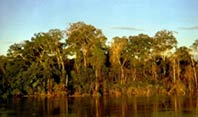

 |
|
|
 |
||
Long after the colonialistic
Conquistadors conquered, and the Catholics so unceremoniously installed a new
religion (mass conversion in the 1950‘s and 1960‘s), there remains
an indigenous Indian people named the Shipibo. They reside in the Peruvian Amazon,
oftentimes a short canoe or peque-peque ride from the burgeoning and populous
jungle city of Pucallpa. The Shibipo, most famous for their embroideries and
the ceremonial vision inducing drug called Ayahuasca (Banisteriopsis Caapri),
arguably live in third world squalor, caught between procuring ancient traditions
and encroaching modernity. Manuela, my travel companion, and I discovered these
people in the impoverished village of Limonjema; a proud village, pregnant with
life and color, like the trees, which invariably bestow haunting numbers of
fruit and medicine.
Conscious that an organized tour to a designated Indian destination might indirectly
exploit the natives, we followed the recommendation of a curandero (shaman)
whom we visited in Pucallpa. He explained that Limonjema would guarantee a true
encounter with the agricultural, spear fishing, bartering Shipibo, and that
Limonjema rarely received visitors. In reality, Limonjema hadn‘t seen a
gringo for three years. Perfect.
After a two-hour ride through the rain in a peque-peque, a banana shaped boat
with a motor; we arrived in the moist hot drizzle laze of Limonjema. Villagers
slowly roused from their hamacas and from behind mosquito netting, and greeted
us with both curiosity and awe.
 |
Toting our heavy ruck-sacks, we walked through the village: huts without walls raised on weathered planks so as to protect themselves from the delugeable Ucayali River, a telephone box, an ancient well that was the villages‘ only water supply, skinny chickens pecking at kernels of uncooked corn (choclo), streams of black ants marching up into the jungle canopy, clouds of pernicious mosquitoes, lizards scampering about to camouflage themselves from prey and their nightmarish predators, and countless trees and plants harboring pucay, cocoa, platanos (bananas), papaya, and more earthly delights. |

The locals, brown-skinned with inquisitive eyes, followed us to the end of the village, where there were large patches of sweet sugar cane (cane azucar). They slowly corralled us, the children barefooted wearing dirty rags, the men bare-chested with black jungle boots and nearly all equipped with machetes. The women’s hair were stained a dark black, as were their hands from the process of draining oil from plants and blood from trees. Willer, a spanish speaking curandero, invited us to camp beside his hut for the evening. Naturally intimidated by our new setting and duly ignorant, we declined his offer. Instead, we camped at the end of the village beside the cane azucar fields. Absolute hell ensued, and deservedly so. We undoubtedly offended him and not to mention, nefarious purple-legged mosquitoes pierced through the tent and terrorized us like greedy little vampires throughout the night.
In the morning, fetid, sweaty,
and itchy, we were greeted by two elderly women clad in bright shirts, squatting
down bare-footed before the entrance to our tent. One animatedly described in
her native tongue that someone had an infection of some kind. She promptly showed
us her left breast. She wanted medicine for something unknown to us, as did
Willer who had something called White Eye and his son who suffered from a skin
disorder spreading over the top of his head. I applied Neosporin onto the young
boy’s head while the grandmother held back his hair. I wanted to cry.
Soon afterwards, the inevitable winter rain pelted down, hastening the soft
fertile earth to slimy mud. Choclo laid out evenly on the ground to dry was
suddenly victimized. The villagers instantaneously began to tackle the ground
and scoop their food up with plastic cylinders and we immediately followed,
sprawling on all fours while depositing the choclo into large burlap sacks.
Then the rain quickly subsided. Everyone was wearing mud suits and laughing
under the sun when a young girl gave us a plate of warm fried bananas (platanos
fritos). I began to think that the further one escapes from ‘society’;
the closer one invariably comes to unearthing humanness.

Willer invited
us to sleep beside his hut again, saying that in the morning he would take us
into the surrounding jungle. We accepted. In the morning we canoed through a
labyrinth of mirrored, crocodile canals, spotting perspiring purple flowers,
medicinal trees, and acrobatic monkeys leaping from vine to branch amongst the
creaking trees and gregarious toucans. A spear fisher gently paddled before
us in a tangle of scraggly branches grazing the apron-smooth water. Everything
was enveloped in green. There was a soporific din, a perceptible effluence of
infinite wonder and life secreting uncontrollably out of every crevice from
the terrifying yet beautiful landscape. I did not want to leave.
Sadly enough, we had to go. They made us promise to return and then the procession
of gifts unraveled. In exchange for money, food, and medicine, we were given
necklaces made from dyed plant seeds, embroidered cloth, and perhaps the most
shocking gift of all - a ceremonial baptism. Dipping their fingers into bowls
of water, the elderly women wet their black index fingers and pressed them to
our foreheads. I inwardly cringed. The Shipibo had truly adopted Western beliefs.
| We walked solemnly to the river, facing a swollen orange sun spilling its pulp behind the horizon. To our backs were the Shipibo, nestled in a somnolent green blanket of beatitude, whom simply just welcomed two gringos to take part in their unguarded everyday lives. They allowed us to enter an undocumented village, one unquestionably off the beaten path. Despite increasing dependencies upon modernity, the Shipibo are beautifully human, instinctively giving, and poised with immeasurable perseverance and grace. They are a proud people pregnant with life and color, like the palmy trees they unconsciously imitate. |  |
All Photography
copyright Dave Knieter
|
|
||
|
© Melt Magazine 2001
|
||